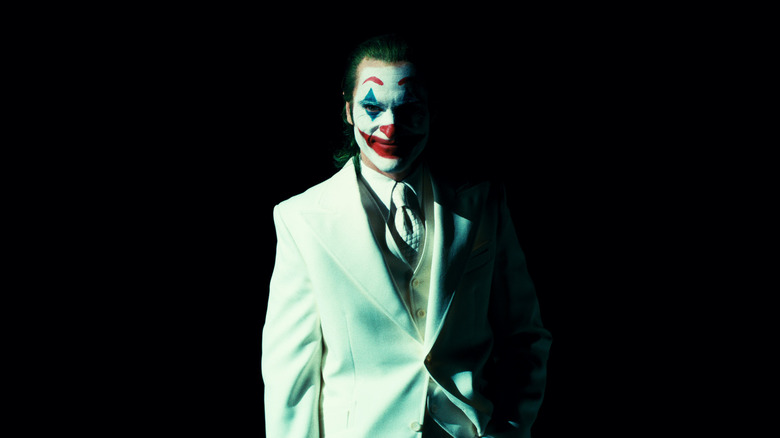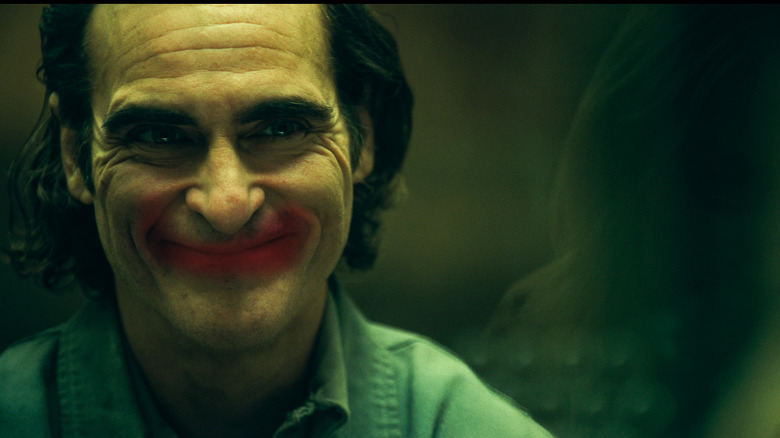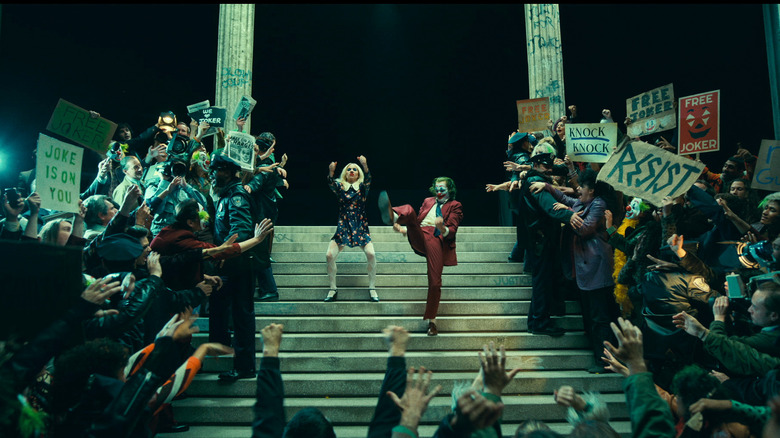Joker 2 Actually Draws A Major Comparison Between Arthur Fleck & Batman
This article contains spoilers for "Joker: Folie à Deux."
When Tim Burton's "Batman Returns" was released in the summer of 1992, a number of fans and critics remarked how little screen time Michael Keaton's Dark Knight had in the movie, with so much real estate given over to Michelle Pfeiffer's Catwoman and Danny DeVito's Penguin. While this unevenness was already the case in the first "Batman," most people assumed that Jack Nicholson's star power being bigger than Keaton's at the time accounted for that. For "Returns," the narrative became that Burton was simply more interested in the colorful, audacious villain characters than the goody two-shoes Dark Knight.
However, as the 30-plus years have demonstrated since the release of "Batman Returns," the open secret about the character of Batman and the films he appears in is that all of his villains — and, if applicable, his allies — are a reflection of himself. Thus, each "Batman" movie has a lot to say about Bruce Wayne and his crime-fighting alter ego, with the villains doubling as a commentary about Wayne's own issues with vigilantism, class, transformative loss, and especially his dual nature. While characters like Catwoman and Two-Face comment on this latter point with obvious metaphor, the Joker has traditionally acted as more of an Id to Batman's Superego; if Batman is Lawful Good, then Joker is Chaotic Evil. That's because Joker's persona is generally wholly his, for he has no secret identity to maintain, and most often is given an ambiguous or completely unknown origin. In other words, he's just Joker.
That all changed with Todd Phillips' 2019 "Joker" film, of course, presenting a man named Arthur Fleck (Joaquin Phoenix) who, in Gotham City circa 1981, begins to lose his sanity and slips further into madness and eventually murder, creating a persona known as the Joker in the process. That film included a version of Bruce Wayne (Dante Pereira-Olson) who is only a child, and ends up suffering the fateful murder of his parents in large part because of Arthur's inciting other criminals. While neither Bruce nor any member of the Wayne family turns up in "Joker: Folie à Deux," the film continues to explore and compare the relationship between the two antagonists in a very intriguing fashion.
Arthur and his shadow
Phillips and co-writer Scott Silver are very up-front about the central thematic conflict of the "Joker" sequel, as it begins with a vintage-style Warner Bros. cartoon entitled "Me + My Shadow," all about how Arthur was possibly influenced and taken over by a malevolent personality dubbed the Joker when he murdered talk show host Murray Franklin (Robert De Niro) at the conclusion of "Joker." That's the narrative Arthur's lawyer, Maryanne Stewart (Catherine Keener), is trying to convince her client as well as a jury of his peers of. For most of the film, Arthur isn't so sure what the truth is, as being on medication makes his "Joker" side seem to fade away, but that could simply be because he's lacking inspiration. Instead of a Batman being out there to complete him (as Heath Ledger's Joker exclaims in "The Dark Knight"), Arthur finds his muse in fellow patient Lee Quinzel (Lady Gaga), who seems to share a similar ethos as he does, if not a similar insanity.
Despite Harley's insistence that Arthur embraces his Joker persona, Arthur isn't so sure who he really is, a plight that's often faced by Bruce Wayne concerning Batman. Just as Bruce is forced to reckon with his goals and actions versus what he represents (and what other people think he represents), Arthur is pushed between his two identities and eventually comes to realize that "there is no Joker," i.e. his actions are his own and not the result of any multiple personality disorder. In this way, "Folie à Deux" makes Arthur/Joker into the anti-Batman, a man who struggles with a dual nature that's of his own making. In the same way most movies about Batman do, "Folie à Deux" highlights Batman's exceptionalism through comparison to a villain: there but for the grace of Gotham goes Bruce.
Batman and Joker remake Gotham in their own image
Yet it's not just themselves with which Arthur and Bruce have to find equilibrium. The actions of each man and the alter egos they create have huge ripple effects that spread throughout the whole of Gotham City, consequences that are to neither man's liking. For Bruce, he's disturbed by the way becoming Batman can act like a self-perpetuating vicious cycle: in Burton's film, it's seen in how Joker is responsible for making Batman and vice versa, whereas in Christopher Nolan's "Dark Knight" trilogy, it's exemplified in the idea of "escalation," how the presence of a figure like Batman draws in competitors and copycats alike. In "The Dark Knight," Batman (Christian Bale) is aghast at discovering a group of men who dress up in low-rent Batsuits and try and fight crime themselves in their own irresponsible way.
Arthur Fleck undergoes a similar moment in "Folie à Deux," discovering that his Joker self has inspired a legion of rabid fans, helped in large part by the media continuing to glorify and lionize his actions via a TV movie (that we never see). While Arthur is, of course, flattered and encouraged by these supporters at first, they quickly grow beyond his or anyone's control, and it's when he's trapped in the back seat of a car with two Joker copycats who act deferential to him (making them ersatz henchmen and Arthur a sort of unwilling cult gang leader) that Arthur becomes horrified. In the same way Bruce rejects unchecked vigilantism, Arthur rejects unchecked mayhem, realizing too late that the impotent rage and despair which caused him to commit his crimes cannot lead to anything resembling a good thing.
Yet although Arthur is morally justified in wanting to leave the Joker behind, the creation of such a mythic character means that there's now a void in Gotham that needs filling. Just as Bruce is compelled to pass on his Batman identity to a colleague in "The Dark Knight Rises," Arthur gets his just desserts at the hands of a one-time admirer, meeting a fate all too similar to Murray. In the "Batman" mythos, Batman and Joker are everywhere and nowhere, everyone and no one, and they're destined to be entwined forever, whether they're in the same movie or not.
"Joker: Folie à Deux" is in theaters everywhere.


